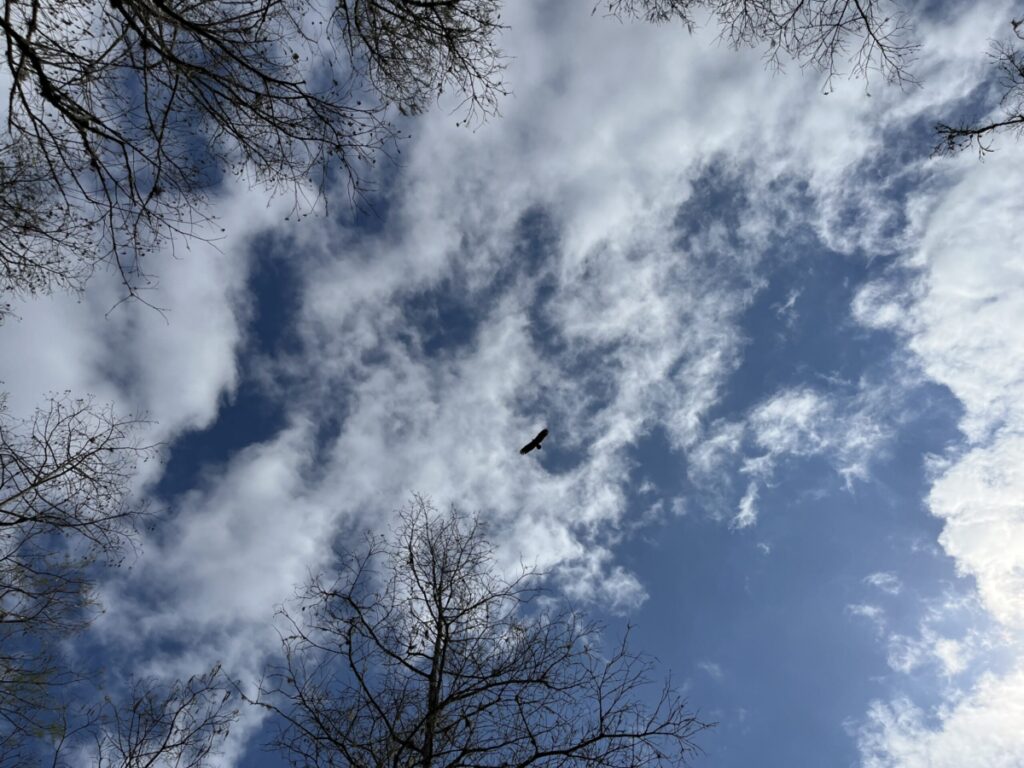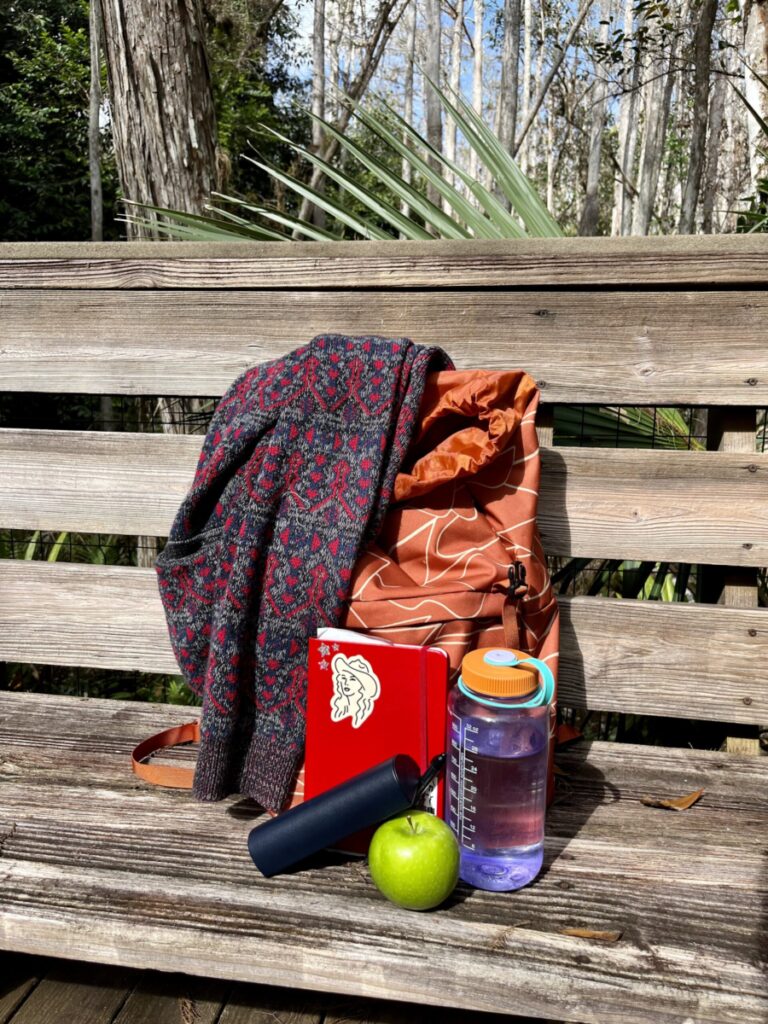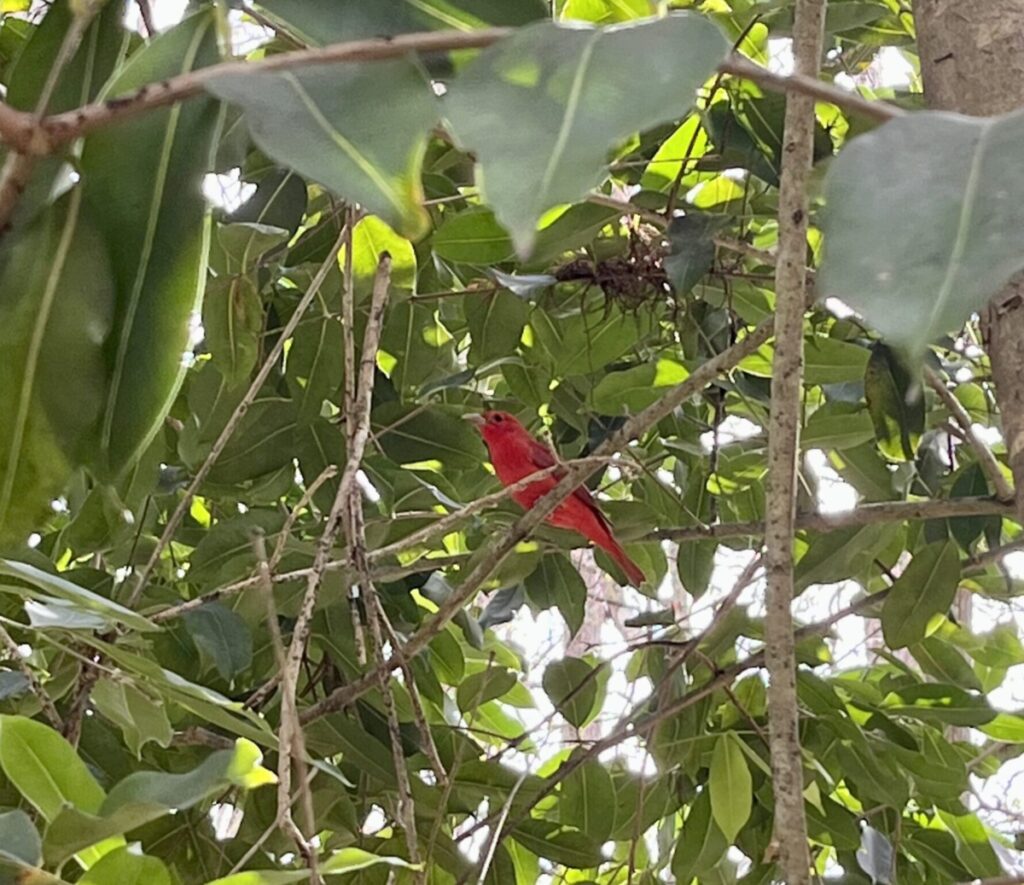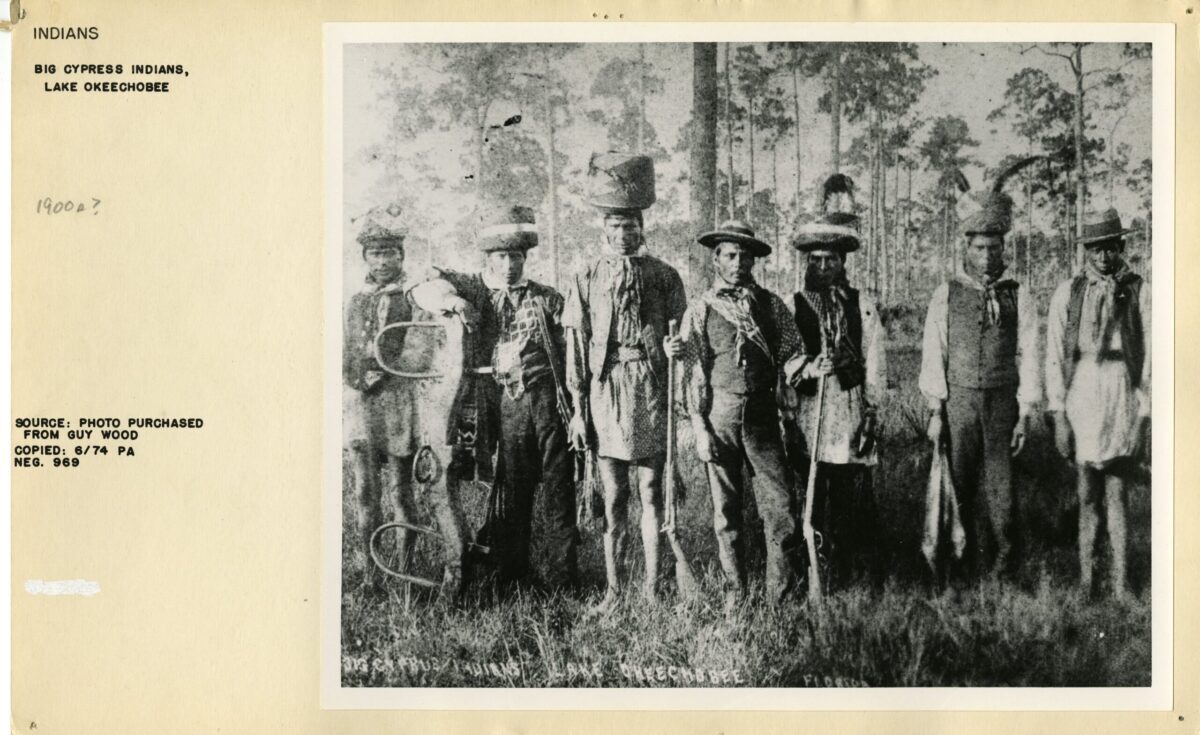
Birds of the Boardwalk
Ready to take a walk with us? Join us to look for birds of the boardwalk! This week, we are sharing a recent excursion to the Ah-Tah-Thi-Ki Museum Boardwalk. Part of the Florida Birding Trail, the Boardwalk is bustling with late winter and early spring birds this time of year. Recently, I spent a few hours on the Ah-Tah-Thi-Ki Museum Boardwalk and campus for a Florida birding day trip. This week, join me on the Ah-Tah-Thi-Ki Museum Boardwalk for tips and tricks for bird identification, my walk experience, and to find out how many birds I identified.
In our featured image today, you can see a panoramic photo I took during my excursion. In it, you can see the dense foliage of the cypress dome, which shelters and houses dozens of types of birds! The mile-long boardwalk winds through a dense cypress dome and is perfect for birders of all abilities. The wide boardwalk is wheelchair accessible, with numerous benches to stop and rest along the loop. There are also stops like the Clan Pavilion, Ceremonial Grounds, Village, and Hunting Camp, where you can learn more about the Seminole Tribe of Florida.

Winter and early Spring Florida Birds at the Ah-Tah-Thi-Ki Museum Boardwalk
Winter and early Spring are a time of flux for Florida birds. Firmly in the dry season, it is one of the best times of year to see a wide variety of wintering birds, as well as local species. At the Ah-Tah-Thi-Ki Museum, “Wading birds, raptors, woodpeckers and songbirds are well-represented.” In the late winter and early spring, numerous warbler species pass through, including “Ovenbird, Northern Waterthrush and American Redstart. Blue-headed Vireo, Gray Catbird, Tree Swallow and Yellow-bellied Sapsucker.” Warblers can be difficult to identify, as they are small, quick birds that tend to look similar. In the winter, many have drab brown and gray coloring, and blend into the leaves. But, they have a big impact on the sounds of the cypress dome, and you will know they are there.
Pileated Woodpecker, Blue-gray Gnatcatcher and White-eyed Vireo can be spotted year-round. In the ponds and water features around the Museum, look for herons, egrets, anhingas, cormorants, and other water and wading birds. As winter transitions into spring, and the wet season begins, more and more wading birds will be visible. Additionally, hawks and owls may nest along the boardwalk, so make sure to look up when you are visiting!
Tips to Having the Best Birding Experience
Download the Audubon App OR Carry a Field Guide
There are hundreds of species of birds that call Florida home, some for a short time during migration season and some year-round. If you are like me, you don’t have the background knowledge to identify all of them. The Audubon App, or a field guide, is a great way to get the most out of your birding experience and learn on the go. For this walk, I used the app to help me identify birds and log sightings. Something I found particularly helpful was the bird call section, where you can listen to different bird call recordings to narrow down an ID.
No Headphones!
I would not have been able to identify many birds I encountered on my boardwalk trip with headphones in. While it is tempting to listen to music while you walk, you will miss the veritable cacophony of Everglades sounds. From trilling, chirping, and squawking birds, to swaying cypress and the creaking of the trees. It is worth taking an uninterrupted moment for yourself and nature!
Slow Down, Look Up, and Listen
It is tempting to power through your walk and get from point A to point B as quickly as possible. But, I would suggest taking this walk slowly if you want to see as many birds as possible. Remember, you are walking through their home in the cypress dome. You are much more likely to see more birds if you slow down and listen. Additionally, look up! In the photo above, you can see a bird flying over as I walked the boardwalk.
Find Places to Sit and Rest
There are many convenient benches along the boardwalk for you to stop and take a rest. Even if you aren’t tired, if you are bird-spotting, it could help to stop for a minute! This will allow you to identify different bird calls and chirps, as well as draw your attention to birds that may have been camouflaged or hiding as you walked past. When you wait and sit for a minute, the cypress dome will come alive!
Pack with a Purpose
When visiting the boardwalk, it is important to pack with a purpose. The boardwalk is a little over a mile long. When packing for my boardwalk trip, I decided to be intentional with my choices and pack lightly, while still bringing everything I needed. Below, you can see my daypack. I included water (you can fill up your bottle inside the Museum), sunglasses, a notebook and pen to take notes about the birds I saw, a snack for after my walk, and a sweater for my time inside the Ah-Tah-Thi-Ki Museum. Not included in the photo are sunscreen (which I applied before I went for my walk), a hat (which I was wearing), and my phone/camera.

The Walk
As I began my walk, I immediately heard and spotted a Pileated Woodpecker near the entrance of the boardwalk loop. In the dense cypress dome, I heard (but could not identify) many warblers, wrens, and other small sparrows. Many blended into the dense foliage of the cypress dome, and I found it hard to identify them. These small birds are so quick, flitting through the leaves and vines as soon as I spotted them. I was able to identify an American Goldfinch with its winter plumage, a White-Eyed Vireo, and many House Sparrows. As I moved past the Clan Pavilion, I heard (but could not see) an owl. Making my way to the Village, I saw many vultures.
While I walked along the boardwalk, I was struck by how many birds I saw. Although many were hard to identify, there were dozens of birds around me at any moment. They were everywhere – swooping over the boardwalk in front of me as I walked. At one point by the Hunting Camp, a hawk flew over the boardwalk about 15 feet in front of me across to the other side. Right before the Hunting Camp, I was able to spot an Anhinga with wings splayed near a wet marshy area of the dome.
Highlight of My Experience
My favorite bird encounter happened at the end, though. As I emerged from the end of the boardwalk loop at the picnic area, I spotted a flash of bright red. Initially, I thought it was a cardinal. But, upon closer inspection, I noted the head shape and size did not quite match. After doing some research, it looks like I was lucky enough to see a Summer Tanager! The only fully red bird in Florida, Summer Tanagers are hard to spot, as they tend to remain hidden among the leaves.

Birds I Encountered
My walk through the Ah-Tah-Thi-Ki Museum Boardwalk took about an hour and fifteen minutes. I started my walk at 1:00p, and finished around 2:15p. The weather during my walk was fantastic, a breezy 75 degrees Fahrenheit and overcast. You could certainly take more time or move through it faster. I walked leisurely and tried to count as many birds as possible over the course of my walk. Additionally, although the boardwalk itself is the only part on the Florida Birding Trail, I chose to count birds from my entire visit to the Ah-Tah-Thi-Ki Museum, including the Sculpture Garden out by the front of the Museum. In my official count, I only identified birds that I could properly speciate on the Museum’s campus. I chose not to include birds I saw on the drive to and from the Museum.
On my journey at the Ah-Tah-Thi-Ki Museum Boardwalk and Sculpture Garden, I identified fifteen birds in total. Ten of them were on my boardwalk experience, and five more were on the greater campus and Sculpture Garden. However, there were many birds that I encountered on my walk that I could not properly identify! Below, you can see my list of birds of the boardwalk and Ah-Tah-Thi-Ki Museum campus.
| Boardwalk | Sculpture Garden | Greater Campus |
| Pileated Woodpecker | Blue Jay | Cattle Egret |
| American Goldfinch | White Ibis | Snail Kite |
| White-Eyed Vireo | Little Blue Heron | |
| House Sparrow | ||
| Turkey Vulture | ||
| Black Vulture | ||
| Anhinga | ||
| Summer Tanager | ||
| American Crow | ||
| Owl |
What will you see?
Whether you are an experienced birder or have never gone before, you will get a lot out of this birding experience! Even if you can only identify a few birds, taking the time to connect with the natural world around you is worth the investment. In just a few hours and with some resources, I identified more birds than I initially expected, and had a great time doing it. This activity is family-friendly, fun, engaging, and relaxing. I encourage you to check out the Ah-Tah-Thi-Ki Museum Boardwalk to have your own Florida birding adventure. Can you spot more birds than I could?
Author Bio
Originally from Washington state, Deanna Butler received her BA in Archaeological Sciences from the University of Washington in 2014. Deanna moved to South Florida in 2016. Soon, she began working for the Seminole Tribe of Florida’s Tribal Historic Preservation Office. Deanna was the THPO’s Archaeological Collections Assistant from 2017-2021. While at the THPO, Deanna worked to preserve, support, and process the Tribe’s archaeological collection. She often wrote the popular Artifact of the Month series, and worked on many community and educational outreach programs. She lives in Fort Myers, FL with her husband, son, and dog.



